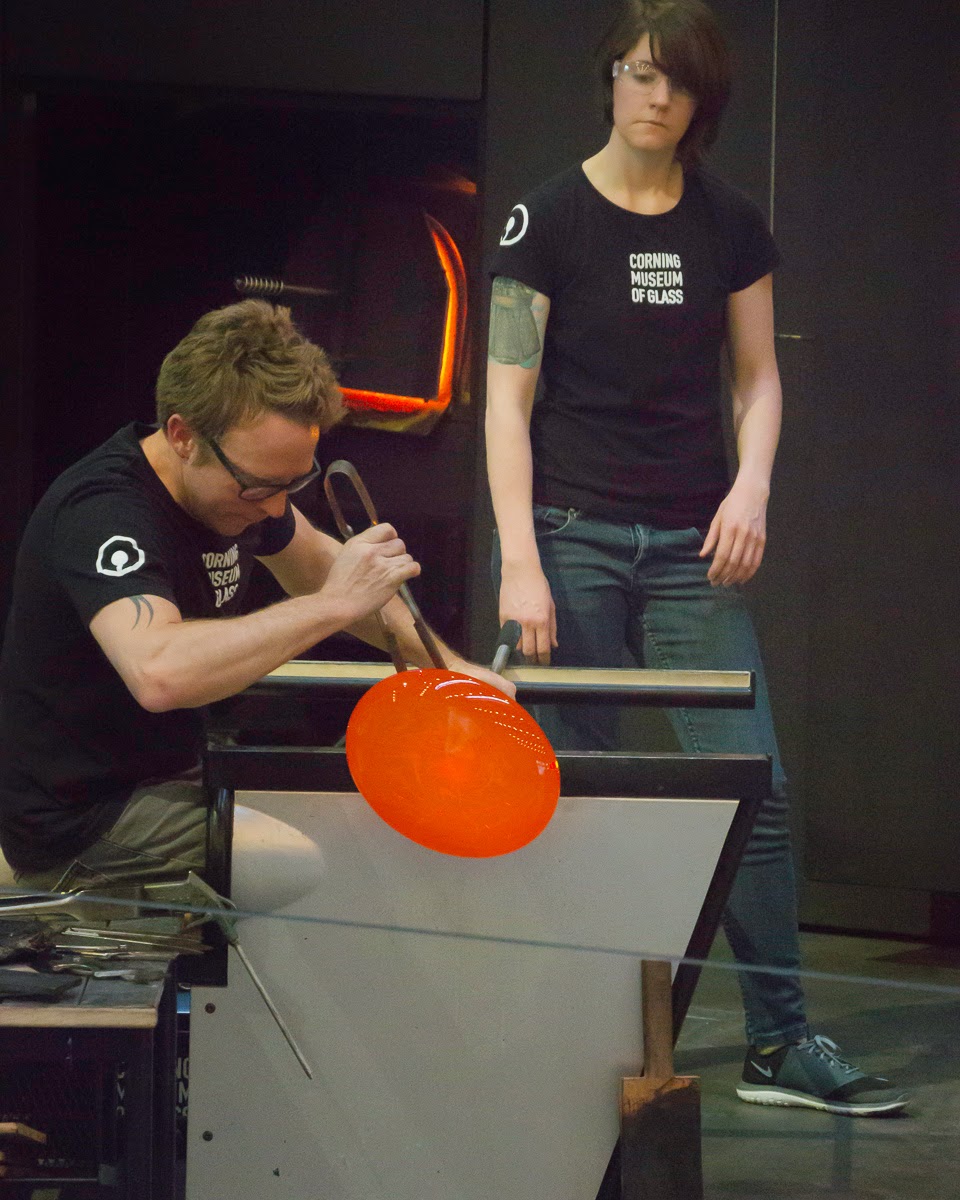Living in Corning, New York keeps one constantly aware of the events at the Corning Museum of Glass. From a first visit in 1971, the CMOG has been a fascinating place. My favorites are in
two dissimilar genres. I love the intricate detail of the
Venetian glass and the beauty of their
forms. Their
collection of whiskey bottles from early Americana has also captured my
attention. And watching hot glass forming is always exciting.
During my forty-four years in the community, the CMOG has evolved in several steps. Each time, the museum has become much more than before. This March, the CMOG opened a new wing that brings huge display spaces for large works of art plus a greatly expanded hot glass theater, where state of the art facilities allow visitors to watch the creation of amazing glass forms not previously possible.

Entering the new gallery of contemporary art and design, the beautiful natural light displays the installations in the best possible way. There is no glare on the brilliant glass surfaces that would come from direct lighting. While easily missed, this is the result of very sophisticated ceiling panels. Throughout, one sees great attention to the details.
The exhibits engage the viewer in many opportunities for discovery. A close look at this large glass platter reveals an intricate detail reminiscent of Venetian glass from centuries earlier. It differs from that genre in the color of the glasses brought forward.

There is also room for large display pieces that engage the mind in an exploration of deeper meaning. The work below combines a fallen chandelier of ruby red glass with apparently ravenous crows.
The gallery of contemporary art and design leads one to the second great addition to CMOG, the hot glass theater. This is where the visitor gains a full appreciation for the artistry seen in the rest of the museum. You see the skill required in a spiral of color in the image above, or in the hundreds of red forms in the assembly at left. For a family, the hot glass show is sure to be a highpoint of the visit, as the children's attention will be complete.
On the day of my visit, a team was creating a large oval platter in a ruby red glass. At the high forming temperatures, the color of the glass is not apparent. The gaffer began with a large gather of glass attached to an iron pontil. Bringing the glass out of the "glory hole" where it is reheated when it has cooled, he sets to forming a precise shape.
While the gaffer is responsible for the overall creation of the object, there is a team of comparably qualified individuals devoted to supporting the lead gaffer. They will form smaller pieces to be attached to the main body and simultaneously work portions of the object as the gaffer directs. It is a team effort, especially when large objects are being worked.
Below you can see the teamwork required to lay a different color glass on the rim of the platter as it nears completion. There are often parallel tasks being done to prepare for future steps in the creation of a piece.
After about an hour's work, the final form is achieved with three skilled gaffers coaxing the platter into shape.
All that is needed is to release the platter from the iron pontil, so the team member can carry it to the annealing oven for a very slow cooling to room temperature.
The visitor to CMOG consistently leaves the hot glass show with a sense of awe, and a new appreciation for the many glass objects seen in the museum. It is a perfect combination of art and technology. This show gives me a greater appreciation of what I see whenever I go into the museum's collection of ancient glass.
As I leave the hot glass show, I think of the challenges to making a simple glass bottle before the age of science. It seems unfathomable that such complex objects were made without thermocouples, chemical analysis, gas furnaces or exotic refractories. This is what makes the Corning Museum of Glass so interesting to me. It is a must see for everyone. If you were there ten years ago, go again. It is so expanded, that it will be like a first visit, again.
Paul Schmitt
 I began this last week scouting for a good location to photograph Eastern Bluebirds. I quickly found them, plus the usual abundance of Tree Swallows competing for their nest boxes. The light was good, but I did not have time or tools to prepare the location for the best results. At right is what I captured for a Tree Swallow. The light is good; the bird is in an active pose. The background is nice too. BUT, the white plastic pipe is plain ugly. The technical details were fine, yet more is needed.
I began this last week scouting for a good location to photograph Eastern Bluebirds. I quickly found them, plus the usual abundance of Tree Swallows competing for their nest boxes. The light was good, but I did not have time or tools to prepare the location for the best results. At right is what I captured for a Tree Swallow. The light is good; the bird is in an active pose. The background is nice too. BUT, the white plastic pipe is plain ugly. The technical details were fine, yet more is needed.




















